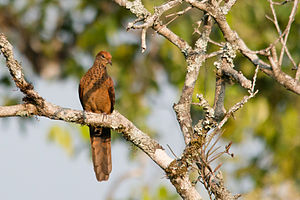Little cuckoo dove
| Little cuckoo dove | ||||||||||
|---|---|---|---|---|---|---|---|---|---|---|

Little cuckoo dove |
||||||||||
| Systematics | ||||||||||
|
||||||||||
| Scientific name | ||||||||||
| Macropygia ruficeps | ||||||||||
| ( Temminck , 1834) |
The little cuckoo pigeon ( Macropygia ruficeps ), also known as the red-coat cuckoo pigeon, is a species of pigeon that belongs to the cuckoo pigeons . It occurs in Southeast Asia. Several subspecies are distinguished.
The population of the small cuckoo pigeon is given as least concern .
Appearance
The little cuckoo pigeon reaches a body length of up to 30.5 centimeters. It is roughly the size of a laughing dove and has the long tail typical of cuckoo pigeons. There is a gender dimorphism .
Appearance of the males
The head and the tease are cinnamon-colored, the neck and the upper coat also have an iridescent green and purple shimmer. The rest of the coat up to the rump is dark brown. The coat is cross-banded. The wing covers are dark brown, the individual feathers have broad chestnut brown edges. The flight feathers are black-brown.
The middle tail feathers are dark brown, the outer ones are reddish brown with a conspicuous black end band. The throat is pale isabel-colored, the rest of the underside of the body is cinnamon-colored, only the flanks and the underside of the tail are maroon. The iris is gray-white to blue-white. The orbital ring is dark gray. The beak is brown and turns black towards the tip of the beak. The feet are coral red.
Appearance of the female and young birds
The female has a dark chestnut brown parting and is spotted with black on the forehead. The neck is yellowish isabel with a black cross banding. In contrast to the male, the cervical plumage is not iridescent. The feathers of the wing covers are lined with a striking maroon. The ear covers are isabel-colored and contrast with the dark parting. The throat is pale isabel-colored, the feathers are lined with dark so that the throat appears clearly scaled. The belly is yellowish red-brown with a subtle transverse banding. The beak is darker than that of the male, the feet are a less intense red than that of the male.
The young birds are similar to the female, but are a little reddish overall. The plumage is more intensely banded and spotted.
distribution and habitat
The lesser cuckoo pigeon is a widespread species in Southeast Asia with a disjoint distribution area .
It occurs from Burma, in the northwest and north of Thailand, in the north of Laos, in Vietnam and in the south of Yunnan. Another distribution area is in the south of the Malay Peninsula. It is also found on the islands of Borneo, Sumatra, Java, Bali, Lombok, Sumbawa, Komodo, Flores, Sumbar, Pantar and Timor. It is a common species, especially in the south of its range.
Way of life
The little cuckoo pigeon lives in pairs or in small groups. It eats small, hard berries, seeds and occasionally grains of rice. It takes food both on the ground and in the treetops. She stays in the lower treetop area. To reproduce it can go all year round.
literature
- David Gibbs, Eustace Barnes and John Cox: Pigeons and Doves - A Guide to the Pigeons and Doves of the World . Pica Press, Sussex 2001, ISBN 90-74345-26-3 .
- Gerhard Rösler: The wild pigeons of the earth - free living, keeping and breeding . M. & H. Schaper Verlag, Alfeld-Hannover 1996, ISBN 3-7944-0184-0 .
Web links
- Macropygia ruficeps in the endangered Red List species the IUCN 2012. Posted by: BirdLife International, 2012. Retrieved on November 5 2016th
- Macropygia ruficeps Call of the Little Cuckoo Dove on Xeno-Canto
Individual evidence
- ↑ a b Macropygia ruficeps in the endangered Red List species the IUCN 2012. Posted by: BirdLife International, 2012. Retrieved on November 5 2016th
- ↑ Gibbs, Barnes and Cox: Pigeons and Doves , p. 275.
- ↑ a b Gibbs, Barnes and Cox: Pigeons and Doves , p. 274.